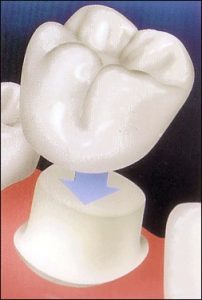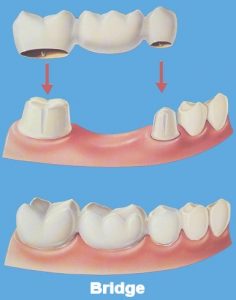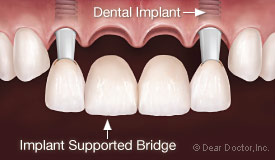Crowns are very common restorative treatments when there is significant decay or damage to a tooth. Bridges are used to replace missing teeth to prevent shifting and improve aesthetics.
Crowns are often used when a tooth has significant decay or damage, typically due to untreated decay or many old fillings. They surround it when the remaining tooth is to thin or weak to withstand normal chewing pressure. They serve to guard your tooth against further damage and restore your bite by mimicking your natural tooth shape. They are tooth-colored to match your adjacent teeth, making them hardly visible. Depending on the damage to your tooth, a filling or an implant may be an alternative we can discuss during your visit.
Bridges are used to replace missing teeth in order to restore appearance and bite but also to keep the surrounding teeth from moving, which can lead to more serious problems. A bridge is just that – a bridge – between neighboring teeth. They are often used in conjunction with extractions as a part of a larger treatment plan but are also commonly used to replace currently missing teeth. Some alternatives to a bridge are an implant, which is longer-lasting and stronger (made of titanium) but more expensive, or a partial denture, which is less expensive but less stable. During your visit, your dentist can help you make the right choice.
The first step is to prepare your tooth for a crown or bridge by trimming around the sides and top of your tooth or, for bridges, its neighboring teeth. This gives room for the crown or bridge to be placed over your tooth to protect it. Sometimes, decay and old fillings may have removed so much tooth structure that we need to build it up to create enough for the fixture to hold onto. Next, we’ll take an impression to send to the lab and place a temporary fixture on your tooth while the lab builds your crown or bridge out of tooth-colored zirconium. After your fixture is ready 2-3 weeks later, we will bond your permanent crown or bridge into place and make sure the bite and appearance are perfect.
If your temporary crown or bridge comes off, please contact our office as soon as possible.
A softer diet is recommended while wearing your temporary crown or bridge. Sticky foods like gum and caramel can pull your temporary off and should be avoided. When flossing, pull the end of the floss out the side of your tooth to avoid dislodging your temporary.
Your gums may be sore for a few days after preparation for your crown or bridge. You may also feel some temperature sensitivity with your temporary but it should diminish once your permanent fixture is placed.
It’s important to keep up good oral hygiene, as always. Crowns can be cleaned with normal flossing and brushing. Bridges can also be brushed regularly but you should use a floss threader to floss because those teeth are bonded together. Your dentist will go over how to do this with you and give you an initial supply of threaders.


